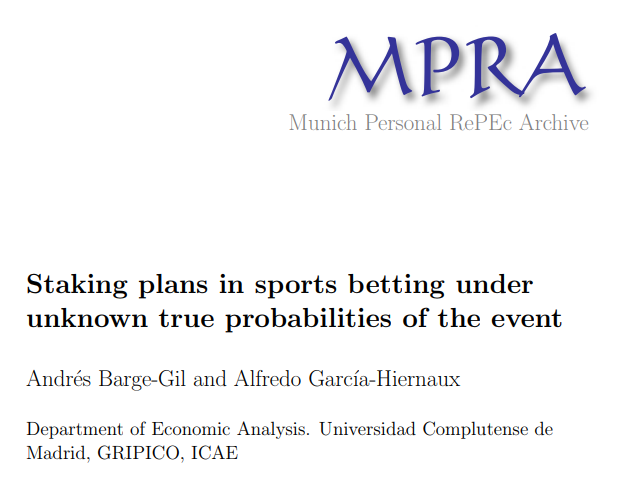Kelly Staking Plan Formula
Posted : admin On 4/4/2022Bettors should always look for a mathematical edge rather than rely on their impulses. Learning how to use the Kelly Criterion, for example, is a great way for bettors to determine how much they should stake. Read on to find out.
- The Kelly criterion formula is: (bp-q)/b. Here: b is the decimal odds of an event -1; p is the probability of success; q is the probability of failure (which can be calculated by 1-p) Fractional Kelly Staking Calculator. One of the disadvantages of the Kelly strategy is that the punter may overestimate the edge, and this could turn out to be a serious mistake.
- Using the Kelly formula, it will look like this: (1.54 –.46) / 1 = 8. That means that based on the information, you should wager 8% of your bankroll on that wager. What’s nice about the Kelly formula is that it will adjust things for you based on your chances of winning.
One of the most complex staking plans, the Kelly Staking strategy requires a mathematical formula to calculate bet sizes. The actual size of the bet is dependent on the edge the gambler has over the bookmaker. One of the complexities involved is being able to accurately work out what your edge is. Martingale System. Kelly criterion mathematical formula. The formula calculates the ideal sum you should stake on any bet, helping minimise your risk and maximise your profits in the long term. The formula is: (bp – q)/b = f. B is your potential winnings, in decimal odds b is simply the odds minus one; p.
Prior to placing a bet bettors should consider six important questions: who, what, when, where, why and how? But for this article, it is the how, as in how much to bet, we are interested in.
Kelly Staking Plan Formula Examples
Popular staking method which suggests that stake should be proportional to the perceived edge.
Consider placing a bet on the English Premier League. We can adapt these questions accordingly:
- Who to bet on? Manchester United
- What to bet on? Top 4 finish
- When to bet on? Now
- Where to bet on? Pinnacle tend to offer the best odds
- Why to bet on? They seem to be under-priced
- How much? How much to bet on this outcome?
Most articles focus on the first five questions, typically using mathematical or statistical justifications on answering ‘why’ - such as the article on how to use Monte Carlo methods.
In making financial decisions, the key issue is not only finding the adequate financial products to invest in but also deciding how to subdivide one’s portfolio. Similarly, an important question for a bettor, is how much to wager?
Many papers recommend using the Kelly Criterion or a derivative of it - such as my 2013 paper appearing in the The Journal of Gambling Business and Economics. In essence, the Kelly Criterion calculates the proportion of your own funds to bet on an outcome whose odds are higher than expected, so that your own funds grow exponentially.
B = the Decimal odds -1
P = the probability of success
Q = the probability of failure (i.e. 1-p)
Using a coin as an example of Kelly Criterion staking
For example, consider you are betting on a coin to land on heads at 2.00. However, the coin is biased and has a 52% chance of ending up on heads.
In this case:
P= 0.52
Q = 1-0.52 = 0.48
B = 2-1 = 1.
This works out at: (0.52x1 – 0.48) / 1 = 0.04
Therefore the Kelly Criterion would recommend you bet 4%. A positive percentage implies an edge in favour of your bankroll, so your funds grow exponentially. You can also test the criterion for different values in this online sheet by using the code below.
Ultimately the Kelly Criterion offers a distinct advantage over other staking methods such as Fibonacci and Arbitrage methods as there is a lower risk. However, it does require precise calculation of the likelihood of an event outcome, and discipline of this method will not provide explosive growth of your bankroll.
Kelly Staking Plan Formula Calculator
Keep up-to-date with more top-notch betting articles by following us on Twitter @PinnacleSports.
A very good explanation of Kelly Betting for back and lay can be found here – Kelly Criterion – Part 3a – Backing and Laying Bets with Betfair.
One of the problems we have with any kelly betting is what to use as our edge.
Kelly Staking Plan Formula Sheet
For help on calculating layers edge please view : https://www.thestakingmachine.com/how-do-we-calculate-layers-edge/
There are 2 ways of looking at lay kelly staking.

- It is the reverse of Back Kelly. So if your fraction to bet in the back kelly calculation is negative. This becomes your lay kelly fraction to bet. The kelly formula is telling you that if you were to place a back bet there is no value in doing so. However if you were to place a lay bet there would be value in doing so.
- It can be calculated from the lay equivalent of the back kelly formula.

Once the fraction to bet is known it can then be divided by our divisor if we have one. The next stake can then be calculated. At this point you must decide whether you are going to use f* to use as your stake OR your liability.
So for
Stake = fraction to bet * Bank Total
or
Kelly Staking Plan Formulary
Liability = fraction to bet * Bank Total

In which case your stake is then calculated according to the liability.
Kelly Staking Plan Formula Example
In TSM you can choose either option. You can also choose whether your Total Bank is fixed or a cumulative total.